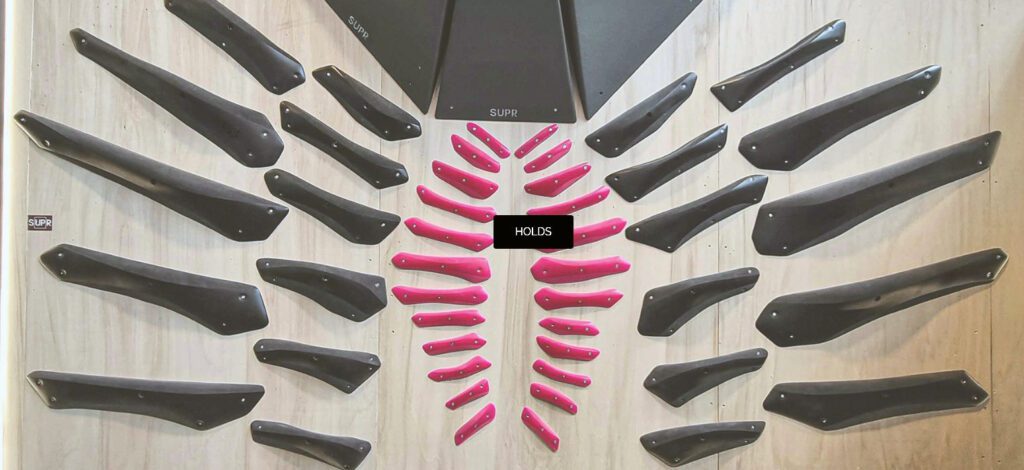La noia seriale delle nuove prese artificiali
Se non le hai non sei una sala alla moda, ma le nuove prese stanno impoverendo il gesto e occupando tanto spazio per niente.
Chiunque frequenti sale d’arrampicata da almeno dieci anni ha potuto toccare con mano i grossi cambiamenti relativi ai movimenti proposti dai tracciatori e al tipo di prese utilizzate per ottenerli.
I gestori delle medesime sale hanno, da parte loro, dovuto toccare con mano l’incremento esponenziale dei prezzi delle nuove prese, certamente più leggere, più industriali, meglio rifinite ma non abbastanza rivoluzionarie da giustificare la rivoluzione dei costi.
L’unica giustificazione reale all’aumento dei prezzi è legata al boom del movimento, all’incremento del numero delle sale e alla conseguente necessità delle aziende produttrici di strutturarsi per cavalcare l’onda, onda che non sembra essere destinata ad abbassarsi nel medio/breve periodo, almeno nei grandi agglomerati urbani.
Per il resto, tanta tanta plastica scivolosa e verniciata, butterata da minoritarie zone grippose, dove piazzare mani e piedi.
Enormi dischi di resina o di plastica, che occupano altrettanto grandi parti di un muro, valorizzabili in punti che talvolta risultano essere addirittura meno del 10% della superficie complessiva.
Vengono spesso definiti spettacolari, fotogenici e probabilmente lo sono, l’effetto scenico specialmente durante le gare è rilevante e contribuisce a rendere meno noiose competizioni che faticano generare emozioni, specie per il pubblico meno specializzato.
Ma al di là di tutto, al di là del costo, degli ingombri, della effettiva utilità di avere prese enormi con piccolissimi punti utilizzabili, resta generalmente ignorata la questione principale: questi “nuovi” appigli stanno impoverendo il gesto tecnico del climbing.
Non facciamoci abbagliare dalla comparsa di triple, canapeche, lanci e corse orizzontali che peraltro nascono, vivono e muoiono all’interno delle competizioni su plastica o nell’ambito del puro divertissement all’interno di una sala commerciale. E che si potevano concepire e realizzare anche con le prese che c’erano nei primi anni 2000.

Una serie Supr, tra le più gettonate in competizione
Il fatto è che, a quasi dieci anni dalla comparsa delle prime prese bitexture con corpo in plastica, le preensioni, cioè i modi con cui queste prese devono essere afferrate e valorizzate, sono sempre della stessa noia mortale: mano aperta, mano aperta, mano aperta. Buco, buco, buco, arcuo arcuo arcuo, pinza pinza pinza.. Più o meno ampie, più o meno profonde, più o meno svasate, queste preensioni sono sempre la ripetizione pedissequa di loro stesse, con serie costosissime pur se costruite con economie di scala che solo un cieco non potrebbe notare. Serie a matrioska con la stessa presa che si ripete dall’enorme al piedino. Che in tante sale, poi, diversi geni di tracciatori non si preoccupano nemmeno di mixare ad altre serie di marche diverse, generando vie e blocchi che loro chiamano “di stile”, ma che sono solo noiose, prevedibili e didatticamente irrilevanti.
La difficoltà di adattare la mano e le dita alla forma delle prese, che è sempre stata un arte e sempre lo sarà finché esisterà la scalata su roccia, in sala quasi non esiste più e per alcuni è diventato persino un tabù, come se la comodità di non “pensare” come va messa la mano sia un plus e non un enorme difetto di questa arrampicata presunta moderna.
Il problema magari non è uno solo, ma il più grosso viene dalle stesse case produttrici: la nuova tecnologia bitexture sembra non consentire, almeno per ora, voli pindarici; e men che meno sembra di poter far assomigliare la plastica alla roccia più di così. …
L’adattamento della mano alla presa, che era una delle maggiori incognite nella progressione lungo le vie anche di competizione, è quasi scomparso, salvo la malsana pratica di sputarsi sui pollici per tenere anche la parte lucida delle prese.
Il problema adesso è leggere la giusta sequenza e indovinare le tallonate richieste dai tracciatori, oltre che coordinare l’intero corpo nei lanci di diversa lunghezza e direzione.
Il che già non è poco, ma è molto più povero del dover negoziare ogni singola presa, riadattarci la mano, sprecare tempo nel correggere i micro errori commessi nel valorizzare gli appigli.
Un giorno, si spera, la tecnologia permetterà un ritorno a un po’ di fantasia nelle forme, ma per adesso si tratta di evitare la plastica lucida e stringere la plastica ruvida. In and out. AGD
If you don’t have them you are not a trendy hall, but the new holds are impoverishing the gesture and taking up so much space for nothing.
Anyone who has been frequenting climbing halls for at least a decade has been able to touch the big changes regarding the movements proposed by the route setters and the type of holds used to achieve them.
The managers of the same halls have, for their part, had to touch the exponential increase in the prices of the new holds, certainly lighter, more industrial, better finished but not revolutionary enough to justify the cost revolution.
The only real justification for the price increase is related to the boom in the movement, the increase in the number of rooms and the consequent need for manufacturing companies to structure themselves to ride the wave, a wave that does not seem likely to abate in the medium/short term, at least in large urban agglomerations.
Otherwise, lots and lots of slippery, painted plastic, pockmarked by minority grippy areas, where to place hands and feet.
Huge disks of resin or plastic, occupying equally large parts of a wall, enhanced in spots that sometimes turn out to be even less than 10 percent of the total area.
They are often called spectacular, photogenic, and they probably are, the scenic effect especially during competitions is relevant and helps to make less boring competitions that struggle to generate excitement, especially for the less specialized public.
But beyond everything, beyond the cost, the encumbrances, the actual usefulness of having huge holds with very small usable points, the main issue remains generally ignored: these “new” holds are impoverishing the technical gesture of climbing.
Let us not be dazzled by the appearance of triples, canapeches, flips and horizontal runs that, moreover, are born, live and die within plastic competitions or in the sphere of pure divertissement within a commercial hall. And which could also be conceived and realized with the holds that were there in the early 2000s.
The fact is that, almost ten years after the appearance of the first bitexture sockets with plastic bodies, the pre-tensions, that is, the ways in which these sockets are to be grasped and enhanced, are still of the same deadly boredom: open hand, open hand, open hand. Hole, hole, hole, arcuo arcuo arcuo, gripper gripper gripper…. More or less wide, more or less deep, more or less flared, these preensions are always the slavish repetition of themselves, with very expensive series though built with economies of scale that only a blind man could not notice. Matryoshka series with the same grip repeated from the huge to the foot. Which in so many halls, then, different geniuses of tracers do not even bother to mix to other series of different brands, generating routes and blocks that they call “style,” but which are just boring, predictable and didactically irrelevant.
The difficulty of adapting the hand and fingers to the shape of holds, which has always been an art and always will be as long as rock climbing exists, in the hall almost no longer exists and has even become taboo for some, as if the convenience of not “thinking” how the hand should be placed is a plus and not a huge flaw in this supposedly modern climbing.
The problem is perhaps not just one, but the biggest one comes from the manufacturers themselves: the new bitexture technology does not seem to allow, at least for now, any Pindaric flights; much less does it seem to be able to make plastic look more like rock than that.
…
The adaptation of the hand to the hold, which was one of the major unknowns in progression along even competition routes, has almost disappeared, except for the unhealthy practice of spitting on one’s thumbs to hold even the shiny part of holds.
The problem now is reading the right sequence and guessing the heels required by the route setters, as well as coordinating the whole body in jumps of different length and direction.
Which is already not little thing, but it is much poorer than having to negotiate every single hold, readjust our hand, waste time in correcting micro mistakes made in dealing with holds. Someday, hopefully, technology will allow a return to a little imagination in shapes, but for now it’s a matter of avoiding shiny plastic and tightening rough plastic. In and out. AGD


Comments are closed.